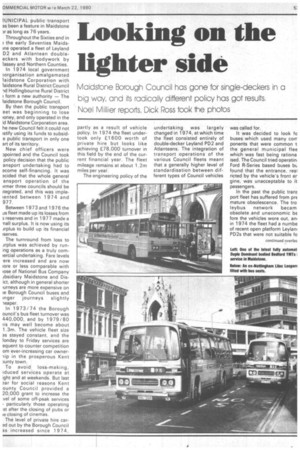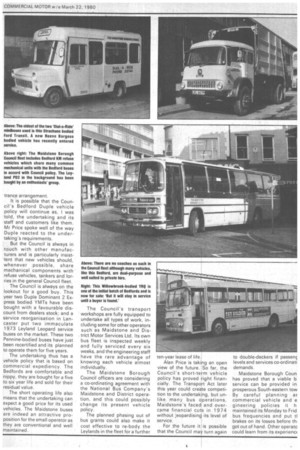Looking on the lighter side
Page 55

Page 56

Page 57

If you've noticed an error in this article please click here to report it so we can fix it.
Vaidstone Borough Council has gone for single-deckers in a big way, and its radically different policy has got results. Noel Villier reports, Dick Ross took the photos
IUNICIPAL public transport as been a feature in Maidstone )r as long as 76 years.
Throughout the Sixties and in ) the early Seventies Maids me operated a fleet of Leyland D2 and Atlantean doubleeckers with bodywork by Iassey and Northern Counties.
In 1974 local government ;organisation amalgamated laidstone Corporation with Iaidstone Rural District Council Hollingbourne Rural District ) form a new authority — The laidstone Borough Council.
By then the public transport eet was beginning to lose money, and only operated in the Id Maidstone Corporation area. he new Council felt it could not istify using its funds to subside public transport in only one art of its territory.
New chief officers were Dpointed and the Council took policy decision that the public ansport undertaking had to e.come self-financing. It was added that the whole general ansport operation of the irmer three councils should be itegrated, and this was implelented between 1974 and 977.
Between 1973 and 1976 the Js fleet made up its losses from 3 reserves and in 1 977 made a nall surplus. It is now using its Jrplus to build up its financial iserves.
The turnround from loss to Jr pl us was achieved by runrig operations as a truly comiercial undertaking. Fare levels .ere increased and are now lore or less comparable with lose of National Bus Company ibsidiary Maidstone and Disict, although in general shorter .urneys are more expensive on me Borough Council buses and
inger journeys slightly lea per.
In 1973/74 the Borough ouncil's bus fleet turnover was 440,000, and by 1979/80 mis may well become about 1.3m. The vehicle fleet size as stayed constant, and the londay to Friday services are equent to counter competition am ever-increasing car ownerlip in the prosperous Kent )unty town.
To avoid loss-making, )duced services operate at ght and at weekends. But last ear for social reasons Kent ounty Council provided a 20,000 grant to increase the vel of some off-peak services particularly those operating st after the closing of pubs or in closing of cinemas.
The level of private hire carad out by the Borough Council as increased since 1974, partly as a result of vehicle policy. In 1 974 the fleet undertook only £1600 worth of private hire but looks like achieving £78,000 turnover in this field by the end of the current financial year. The fleet mileage remains at about 1.2m miles per year.
The engineering policy of the undertaking was largely changed in 1974, at which time the fleet consisted entirely of double-decker Leyland PD2 and Atlanteans. The integration of transport operations of the various Council fleets meant that a generally higher level of standardisation between different types of Council vehicles was called for.
It was decided to look fa buses which used many corr ponents that were common t the general municipal flee which was fast being rationa ised. The Council tried operatin. Ford R-Series based buses bL found that the entrance, resi ricted by the vehicle's front er gine, was unacceptable to it passengers.
In the past the public tram port fleet has suffered from prE mature obsolescence. The tro leybus network becam obsolete and uneconomic bE fore the vehicles wore out, an in 1974 the fleet had a numbe of recent open platform Leylani PD2s that were not suitable fo ne-man operation — by then le only economic way to run le bus services.
The transport committee deided that buses with a shorter ,lanned economic life should be Ised to avoid problems of prenature obsolescence caused by hanging conditions.
With four of the PD2s beginling to need some money spent ,n them and the difficulty of ,btaining Spare parts, suitable oplacements were sought.
In view of the need to achieve degree of interchangeability ,etween bus and general translort fleets it was decided not to iuy Leylands at that time — the eneral transport fleet Leylands would have been from the tediine range which was not uitable as a basis for a bus fleet.
Four Willowbrook-bodied Sedford YRQs were purchased or the lighter routes in the own. These were generally well Iccepted by platform staff and ia.ssengers, although some omplained that entry to the bus as made difficult by its high tep height.
A number of larger Bedford 'RTs were then bought to eplace the remainder of the
PD2s on lighter duties, but these found their way. on to all , the Council's routes.
In 1976 an unexpected chance arose to replace 14 of the Atlantean double-deckers, which were becoming expensive to maintain, with 14 Leyland Leopard dual-purpose coaches.
The Leopards were part of the City of Nottingham's Lilac Leopard fleet bought to provide park and ride services in conjunction with that city's failed zone and collar traffic system. An offer favourable to both undertakings was made for 14 of the Duple-bodied vehicles.
The Lilac Leopards retained their name and livery and proved popular with crews, but the coach seats were not too popular with passengers. A ten year service life in Maidstone is intended for the heavy Leopards.
When the Lilac Leopards entered service in 1976 only eight double-deckers remained in the fleet. These were replaced with Duple Dominant bodied Bedford YMTs fitted with Allison fully automatic gearboxes. They have a passenger capacity of 69 (including standing passengers) and features two and three seating at the rear of the' saloon.
A number of other Bedford Duple Express type dualpurpose coaches have been ad ded to the fleet when the opp tunity to make commerc fi
favourable –opportur0 purchases has arisen.
The Borough Council in period also took over a priv run dial-a-ride service, and tinued to operate this wi Strachens bodied Ford Tr a and a new Reeves Burqe bodied Transit. The servile I fairly well used and gene a pays for itself, although it i particularly profitable.
The original Willowb bodied YRQs and YRTs are being advertised for sale an being replaced. Trans Officer Alan Price told met I was hoped to replace t buses with Bedford JJL buses which would adequate capacity for the to lighter routes and feature son automatic gearboxes many shared components other Council vehicles.
With their low floor tl h seemed particularly attracili but Bedford is still not abli60 say when the vehicle will eln production.
The Leyland Cub, wilh Wadham Stringer, VangLia body, was considered too. 4l Price told me he was impre by the body, but the fron gine layout made it impos to achieve an acceptable trance arrangement.
It is possible that the Council's Bedford Duple vehicle policy will continue as, I was told, the undertaking and its staff and customers like them. Mr Price spoke well of the way Duple reacted to the undertaking's requirements.
But the Council is always in touch with other manufacturers and is particularly insisttent that new vehicles should, whenever possible, share mechanical components with refuse vehicles, tankers and lorries in the general Council fleet.
The Council is always on the lookout for a good buy. This year two Duple Dominant 2 Express bodied YMTs have been bought with a favourable discount from dealers stock; and a service reorganisation in Lancaster put two immaculate 1973 Leyland Leopard service buses on the market. These two Pennine-bodied buses have just been recertified and its planned to operate them for five years.
The undertaking thus has a vehicle policy that is based on commercial expediency. The Bedfords are comfortable and nippy, they are bought for a five to six year life and sold for their residual value.
The short operating life also means that the undertaking can expect a good price for its used vehicles. The Maidstone buses are indeed an attractive proposition for the small operator as they are conventional and well maintained. The Council's transport workshops are fully equipped to undertake all types of work, including some for other operators such as Maidstone and District Motor Services Ltd. Its own bus fleet is inspected weekly and fully serviced every six weeks, and the engineering staff have the rare advantage of knowing each vehicle almost individually.
The Maidstone Borough Council officers are considering a co-ordinating agreement with the National Bus Company's Maidstone and District operation, and this could possibly change its present vehicle policy.
The planned phasing out of bus grants could also make it cost effective to re-body the Leylands in the fleet for a further ten-year lease of life.
Alan Price is taking an open view of the future. So far, the Council's short-teem vehicle policy has proved right financially. The Transport Act later this year could create competition to the undertaking, but unlike many bus operations, Maidstone's faced and overcame financial cuts in 1974 without eopardising its level of service.
For the future it; is possible that the Council maY turn again to double-deckers if passenc levels and services co-ordinati demands.
Maidstone Borough Coun has proved that a viable b service can be provided in prosperous South-eastern tow By careful planning ar commercial vehicle and e gineering policies it h maintained its Monday to Frid bus frequencies and put tl brakes on its losses before th, got out of hand. Other operate could learn from its experiencE
































































































































